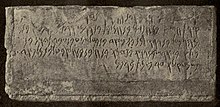| Olbia pedestal | |
|---|---|
 1911 copy of the inscription 1911 copy of the inscription | |
| Writing | Punic |
| Discovered | 1911 |
The Olbia pedestal is a Punic language inscription from the century BCE, found 1911 at Olbia in Sardinia.
It was first assessed by Italian orientalist Ignazio Guidi.
It was first published by Jean-Joseph-Léandre Bargès, and is known as KAI 68 and R 1216.
It was originally held in the Sassari Archeological Museum, but today is held on display at the Museo Archeologico di Olbia.
Discovery

During the 1911 excavations of the city of Olbia (then named "Terranova Pausania") led by Antonio Taramelli, the fragments of a small pyramid-shaped arula were found on a rectangular pillar next to "tower B". The pillar was found to have a Punic inscription on its granite base. It was found in a location where a tomb was erected in Roman times.
Inscription
The inscription is damaged in the first line, just the name of the god or person it was devoted to has been lost.
The script is considered similar to that of the Carthaginian tombstones inscriptions, and was dated to the 3rd century BCE.
Ignazio Guidi wrote that "Although mutilated, the inscription is remarkable for the time it refers to, which corresponds to the period of the absolute domination of the city of Carthage in Olbia, for the mention of Carthage that we see in the inscription itself, for the series of names which belong to those common in the Punic metropolis. Hannibal, Himilkat, Germelkart, Maharbal and the others are common to the Punic name: the name of Ariš recently appeared also in an amphora with a painted inscription, found in the last excavations of the Cagliari necropolis. The inscription therefore attests to the existence of cults and places of worship in the city of Olbia, and increases the hope that systematic excavations can provide new elements on Carthaginian rule in the city of Olbia."
Bibliography
- Antonio Taramelli, Terranova Pausania, Sardinia: Avanzi dell'antica Olbia, rimessi a luce in occasione dei lavori di bonifica, Notizie degli scavi di antichità, 1911, fascicolo 5, pages 223-243
- Campus, Alessandro (2014-11-25). "Una genealogia punica: l'iscrizione ICO Sard. 34, in Da Olbìa a Olbia. 2500 anni di storia di una città mediterranea. Atti del convegno internazionale di Studi (Olbia, 12-14 maggio 1994), Sassari 1996, I, pp. 207-217". Academia.edu (in Italian). Retrieved 2022-10-13.
References
- Taramelli, 1911
- Taramelli, 1911, p242: "Questa importante inscrizione punica, per dono del cav. Tomaso Tamponi, trovasi ora nel lì. Museo di Sassari"
- Taramelli, 1911, p239: "Sia che la cinta murata si possa riferire all'epoca della conquista romana, alla fine del II sec. a. C. 0 ad un'epoca di qualche tempo più tarda, parrebbe di poter asserire che questo lavoro imponente di carattere militare, come deve aver compreso forse un nucleo di edifici e di cantieri e depositi navali più antichi, così dovette occupare aree consacrate, recinti sacri d'epoca punica ed abbatterne gli edifici o i monumenti votivi; così spiegheremo non solo i frammenti di una piccola arula a forma di piramide tronca poggiata su una base rettangolare, arula alta complessivamente m. 0,16, rinvenuta nelle terre accanto alla torre B, ma anche l'importante iscrizione punica, la quale sorgeva sulla sua base granitica, proprio nel luogo dove fu eretta in età romana la tomba, e clie per qualche ragione non bene chiara, o semplicemente come materiale di costruzione, fu immessa nella tomba stessa mentre il pilastro di sostegno rimase a terra, anzi sotterra, accanto al monumento funerario."
- Taramelli, 1911, p240: "L'iscrizione punica, che ba qualche abrasione ed è mutila nella linea più importante, nella prima, riprodotta nella fotografia (fig. 13), fu da me comunicata al prof. Ignazio Guidi, il quale, confermando l'opinione da me espressa in base alla forma del piedistallo, riconobbe nell'inscrizione stessa il carattere votivo. Riporto integralmente l'interpretazione da lui data in una lettera clie egli mi permette di pubblicare."
- Taramelli, 1911, p240: "L'iscrizione è in bel carattere punico, simile a quello delle iscrizioni cartaginesi, e può risalire, parmi, al III secolo av. Cr. Come Ella aveva già dedotto dalla forma della base dell'iscrizione, questa è votiva, ma disgraziatamente nella prima linea non si legge la divinità cui è fatta l'offerta e il nome del dedicante."
- Taramelli, 1911, p242: "Per quanto mutila, l'iscrizione è notevole per l'epoca a cni si riferisce, che corrisponde al periodo dell'assoluto dominio della città di Cartagine in Olbia, per l'accenno a Cartagine che vediamo nella iscrizione stessa, per la serie dei nomi che appartengono a quelli comuni nella metropoli punica. Hannibal, Himilkat, Germelkart, Maharbal e gli altri sono comuni alla onomastica punica: il nome di Ariš è comparso recentemente anche in un'anfora con inscrizione dipinta, ritrovata negli ultimi scavi della necropoli di Cagliari. L'iscrizione ci attesta quindi l'esistenza di culti e di luoghi di culto nella città di Olbia, ed accresce la speranza che scavi sistematici possano fornire nuovi elementi sul dominio cartaginese nella città di Olbia."